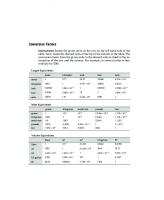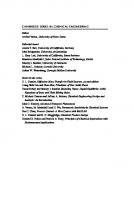Chemical Process Safety: Fundamentals with Applications Fourth Edition (International Series in the Physical and Chemical Engineering Sciences) 9780134857770, 0134857771
The #1 Process Safety Guide, Now Extensively Updated for Current Industrial Processes, Systems, and Practices Process sa
193 73 13MB
English Pages 656 [1118]
Table of contents :
Cover Page
About This eBook
Half-Title Page
Title Page
Copyright Page
Contents
Preface
Acknowledgments
About the Authors
Nomenclature
Chapter 1. Introduction
1-1 Engineering Ethics
1-2 Myths about Process Safety
1-3 Safety Culture
1-4 Individual Risk, Societal Risk, and Risk Populations
1-5 Voluntary and Involuntary Risk
1-6 Safety Metrics
1-7 Accident and Loss Statistics
1-8 Risk Perception
1-9 Risk Tolerance/Acceptance and Risk Matrix
1-10 Codes, Standards, and Regulations
1-11 Safeguards
1-12 The CCPS 20 Elements of Risk-Based Process Safety
1-13 Inherently Safer Design
1-14 The Worst Chemical Plant Tragedy: Bhopal, India, 1984
1-15 Overview of Chemical Process Safety
Suggested Reading
Problems
Chapter 2. Toxicology
2-1 How Toxicants Enter the Body
2-2 How Toxicants Are Eliminated from the Body
2-3 Effects of Toxicants on the Body
2-4 Toxicological Studies
2-5 Dose versus Response
2-6 Dose and Response Using Probit Equation
2-7 Relative Toxicity
2-8 Threshold Limit Values
Online Resources
Suggested Reading
Problems
Chapter 3. Industrial Hygiene
3-1 Anticipating and Identifying Hazardous Workplace Exposures
3-2 Globally Harmonized System
3-3 Evaluate the Magnitude of Exposures and Responses
3-4 Develop and Evaluate Control Techniques to Prevent Exposures
3-5 National Fire Protection Association Diamond
Online Resources
Suggested Reading
Problems
Chapter 4. Source Models
4-1 Introduction to Source Models
4-2 Flow of Liquid through a Hole
4-3 Flow of Liquid through a Hole in a Tank
4-4 Flow of Liquids through Pipes
4-5 Flow of Gases or Vapors through Holes
4-6 Flow of Gases or Vapors through Pipes
4-7 Flashing Liquids
4-8 Liquid Pool Evaporation or Boiling
4-9 Realistic and Worst-Case Releases
4-10 Conservative Analysis
Suggested Reading
Problems
Chapter 5. Hazardous Material Dispersion
5-1 Parameters Affecting Dispersion
5-2 Neutrally Buoyant Dispersion Models
5-3 Pasquill–Gifford Model
5-4 Dense Gas Dispersion
5-5 Toxic Effect Criteria
5-6 Release Prevention and Mitigation
Suggested Reading
Problems
Chapter 6. Fires and Explosions
6-1 The Fire Triangle
6-2 Distinction between Fires and Explosions
6-3 Definitions
6-4 Flammability Characteristics of Liquids and Vapors
6-5 Flammability Characteristics of Dusts
6-6 Sprays and Mists
6-7 Ignition Energy
6-8 Ignition Sources
6-9 Experimental Characterization of Gas/Vapor and Dust Explosions
6-10 Explosions
Suggested Reading
Problems
Chapter 7. Concepts to Prevent Fires and Explosions
7-1 Inerting
7-2 Static Electricity
7-3 Controlling Static Electricity
7-4 Explosion-Proof Equipment and Instruments
7-5 Ventilation
7-6 Sprinkler Systems
7-7 Industry’s Fire and Explosion Protection Strategy
Suggested Reading
Problems
Chapter 8. Chemical Reactivity
8-1 Background Understanding
8-2 Commitment, Awareness, and Identification of Reactive Chemical Hazards
8-3 Characterization of Reactive Chemical Hazards Using Calorimeters
8-4 Controlling Reactive Hazards
Suggested Reading
Problems
Chapter 9. Introduction to Reliefs
9-1 Relief Concepts
9-2 Definitions
9-3 Code Requirements
9-4 Relief System Design
9-5 Relief Types and Characteristics
9-6 Relief Installation Practices
9-7 Relief Effluent Handling
Suggested Reading
Problems
Chapter 10. Relief Sizing
10-1 Set Pressure and Accumulation Limits for Reliefs
10-2 Relief Sizing for Liquid Service
10-3 Relief Sizing for Vapor and Gas Service
10-4 Two-Phase Flow during Runaway Reaction Relief
10-5 Deflagration Venting for Dust and Vapor Explosions
10-6 Venting for Fires External to the Process
10-7 Reliefs for Thermal Expansion of Process Fluids
Suggested Reading
Problems
Chapter 11. Hazards Identification and Evaluation
11-1 Introduction to Hazard Identification/Evaluation and Risk Analysis
11-2 Non-Scenario-Based Hazard Identification/Evaluation Methods
11-3 Scenario-Based Hazard Identification/Evaluation Methods
11-4 Documentation and Actions Required for Hazard Identification and Evaluation
Problems
Chapter 12. Risk Analysis and Assessment
12-1 Review of Probability Theory
12-2 Event Trees
12-3 Fault Trees
12-4 Bow-Tie Diagrams
12-5 Quantitative Risk Analysis
12-6 Layer of Protection Analysis
12-7 Risk Assessment
Suggested Reading
Problems
Chapter 13. Safety Strategies, Procedures, and Designs
13-1 Process Safety Strategies
13-2 Safe Operating Procedures
13-3 Safe Work Practices
13-4 Designs for Process Safety
13-5 Designs for Runaway Reactions
13-6 Designs and Practices for the Safe Handling of Dusts
Suggested Reading
Problems
Chapter 14. Case Histories and Lessons Learned
14-1 Process Safety Culture
14-2 Compliance with Standards
14-3 Process Safety Competency
14-4 Workplace Involvement
14-5 Stakeholder Outreach
14-6 Process Knowledge Management
14-7 Hazard Identification and Risk Analysis
14-8 Operating Procedures
14-9 Safe Work Practices
14-10 Asset Integrity and Reliability
14-11 Contractor Management
14-12 Training and Performance Assurance
14-13 Management of Change
14-14 Operational Readiness
14-15 Conduct of Operations
14-16 Emergency Management
14-17 Incident Investigation
14-18 Measurement and Metrics
14-19 Auditing
14-20 Management Review and Continuous Improvement
14-21 Summary
Suggested Reading
Problems
Appendix A. Unit Conversion Constants
Appendix B. Flammability Data for Selected Hydrocarbons
Appendix C. Saturation Vapor Pressure Data
Appendix D. Special Types of Reactive Chemicals
Appendix E. Hazardous Chemicals Data for a Variety of Chemical Substances
Appendix F. Process Diagrams
Index
Cover Page
About This eBook
Half-Title Page
Title Page
Copyright Page
Contents
Preface
Acknowledgments
About the Authors
Nomenclature
Chapter 1. Introduction
1-1 Engineering Ethics
1-2 Myths about Process Safety
1-3 Safety Culture
1-4 Individual Risk, Societal Risk, and Risk Populations
1-5 Voluntary and Involuntary Risk
1-6 Safety Metrics
1-7 Accident and Loss Statistics
1-8 Risk Perception
1-9 Risk Tolerance/Acceptance and Risk Matrix
1-10 Codes, Standards, and Regulations
1-11 Safeguards
1-12 The CCPS 20 Elements of Risk-Based Process Safety
1-13 Inherently Safer Design
1-14 The Worst Chemical Plant Tragedy: Bhopal, India, 1984
1-15 Overview of Chemical Process Safety
Suggested Reading
Problems
Chapter 2. Toxicology
2-1 How Toxicants Enter the Body
2-2 How Toxicants Are Eliminated from the Body
2-3 Effects of Toxicants on the Body
2-4 Toxicological Studies
2-5 Dose versus Response
2-6 Dose and Response Using Probit Equation
2-7 Relative Toxicity
2-8 Threshold Limit Values
Online Resources
Suggested Reading
Problems
Chapter 3. Industrial Hygiene
3-1 Anticipating and Identifying Hazardous Workplace Exposures
3-2 Globally Harmonized System
3-3 Evaluate the Magnitude of Exposures and Responses
3-4 Develop and Evaluate Control Techniques to Prevent Exposures
3-5 National Fire Protection Association Diamond
Online Resources
Suggested Reading
Problems
Chapter 4. Source Models
4-1 Introduction to Source Models
4-2 Flow of Liquid through a Hole
4-3 Flow of Liquid through a Hole in a Tank
4-4 Flow of Liquids through Pipes
4-5 Flow of Gases or Vapors through Holes
4-6 Flow of Gases or Vapors through Pipes
4-7 Flashing Liquids
4-8 Liquid Pool Evaporation or Boiling
4-9 Realistic and Worst-Case Releases
4-10 Conservative Analysis
Suggested Reading
Problems
Chapter 5. Hazardous Material Dispersion
5-1 Parameters Affecting Dispersion
5-2 Neutrally Buoyant Dispersion Models
5-3 Pasquill–Gifford Model
5-4 Dense Gas Dispersion
5-5 Toxic Effect Criteria
5-6 Release Prevention and Mitigation
Suggested Reading
Problems
Chapter 6. Fires and Explosions
6-1 The Fire Triangle
6-2 Distinction between Fires and Explosions
6-3 Definitions
6-4 Flammability Characteristics of Liquids and Vapors
6-5 Flammability Characteristics of Dusts
6-6 Sprays and Mists
6-7 Ignition Energy
6-8 Ignition Sources
6-9 Experimental Characterization of Gas/Vapor and Dust Explosions
6-10 Explosions
Suggested Reading
Problems
Chapter 7. Concepts to Prevent Fires and Explosions
7-1 Inerting
7-2 Static Electricity
7-3 Controlling Static Electricity
7-4 Explosion-Proof Equipment and Instruments
7-5 Ventilation
7-6 Sprinkler Systems
7-7 Industry’s Fire and Explosion Protection Strategy
Suggested Reading
Problems
Chapter 8. Chemical Reactivity
8-1 Background Understanding
8-2 Commitment, Awareness, and Identification of Reactive Chemical Hazards
8-3 Characterization of Reactive Chemical Hazards Using Calorimeters
8-4 Controlling Reactive Hazards
Suggested Reading
Problems
Chapter 9. Introduction to Reliefs
9-1 Relief Concepts
9-2 Definitions
9-3 Code Requirements
9-4 Relief System Design
9-5 Relief Types and Characteristics
9-6 Relief Installation Practices
9-7 Relief Effluent Handling
Suggested Reading
Problems
Chapter 10. Relief Sizing
10-1 Set Pressure and Accumulation Limits for Reliefs
10-2 Relief Sizing for Liquid Service
10-3 Relief Sizing for Vapor and Gas Service
10-4 Two-Phase Flow during Runaway Reaction Relief
10-5 Deflagration Venting for Dust and Vapor Explosions
10-6 Venting for Fires External to the Process
10-7 Reliefs for Thermal Expansion of Process Fluids
Suggested Reading
Problems
Chapter 11. Hazards Identification and Evaluation
11-1 Introduction to Hazard Identification/Evaluation and Risk Analysis
11-2 Non-Scenario-Based Hazard Identification/Evaluation Methods
11-3 Scenario-Based Hazard Identification/Evaluation Methods
11-4 Documentation and Actions Required for Hazard Identification and Evaluation
Problems
Chapter 12. Risk Analysis and Assessment
12-1 Review of Probability Theory
12-2 Event Trees
12-3 Fault Trees
12-4 Bow-Tie Diagrams
12-5 Quantitative Risk Analysis
12-6 Layer of Protection Analysis
12-7 Risk Assessment
Suggested Reading
Problems
Chapter 13. Safety Strategies, Procedures, and Designs
13-1 Process Safety Strategies
13-2 Safe Operating Procedures
13-3 Safe Work Practices
13-4 Designs for Process Safety
13-5 Designs for Runaway Reactions
13-6 Designs and Practices for the Safe Handling of Dusts
Suggested Reading
Problems
Chapter 14. Case Histories and Lessons Learned
14-1 Process Safety Culture
14-2 Compliance with Standards
14-3 Process Safety Competency
14-4 Workplace Involvement
14-5 Stakeholder Outreach
14-6 Process Knowledge Management
14-7 Hazard Identification and Risk Analysis
14-8 Operating Procedures
14-9 Safe Work Practices
14-10 Asset Integrity and Reliability
14-11 Contractor Management
14-12 Training and Performance Assurance
14-13 Management of Change
14-14 Operational Readiness
14-15 Conduct of Operations
14-16 Emergency Management
14-17 Incident Investigation
14-18 Measurement and Metrics
14-19 Auditing
14-20 Management Review and Continuous Improvement
14-21 Summary
Suggested Reading
Problems
Appendix A. Unit Conversion Constants
Appendix B. Flammability Data for Selected Hydrocarbons
Appendix C. Saturation Vapor Pressure Data
Appendix D. Special Types of Reactive Chemicals
Appendix E. Hazardous Chemicals Data for a Variety of Chemical Substances
Appendix F. Process Diagrams
Index

- Author / Uploaded
- Daniel A. Crowl
- Joseph F. Louvar
![Chemical Process Safety: Fundamentals with Applications [2nd Edition]
0130181765, 9780130181763](https://ebin.pub/img/200x200/chemical-process-safety-fundamentals-with-applications-2nd-edition-0130181765-9780130181763.jpg)

![Systematic Methods of Chemical Process Design (Prentice Hall International Series in the Physical and Chemical Engineering Sciences) [1 ed.]
0134924223, 9780134924229](https://ebin.pub/img/200x200/systematic-methods-of-chemical-process-design-prentice-hall-international-series-in-the-physical-and-chemical-engineering-sciences-1nbsped-0134924223-9780134924229.jpg)
![Chemical process safety: fundamentals with applications [2nd ed]
9780130181763, 0-13-018176-5](https://ebin.pub/img/200x200/chemical-process-safety-fundamentals-with-applications-2nd-ed-9780130181763-0-13-018176-5.jpg)

![Chemical engineering plant design (Chemical engineering series) [4th ed.]](https://ebin.pub/img/200x200/chemical-engineering-plant-design-chemical-engineering-series-4thnbsped.jpg)
![Chemical Engineering Volume 6, Third Edition: Chemical Engineering Design (Coulson and Richardson's Chemical Engineering Series) [3 ed.]
0750641428, 9780750641425](https://ebin.pub/img/200x200/chemical-engineering-volume-6-third-edition-chemical-engineering-design-coulson-and-richardsons-chemical-engineering-series-3nbsped-0750641428-9780750641425.jpg)
![Food Process Modeling and Control: Chemical Engineering Applications (Topics in Chemical Engineering) [1 ed.]
9056991434, 9789056991432](https://ebin.pub/img/200x200/food-process-modeling-and-control-chemical-engineering-applications-topics-in-chemical-engineering-1nbsped-9056991434-9789056991432.jpg)

